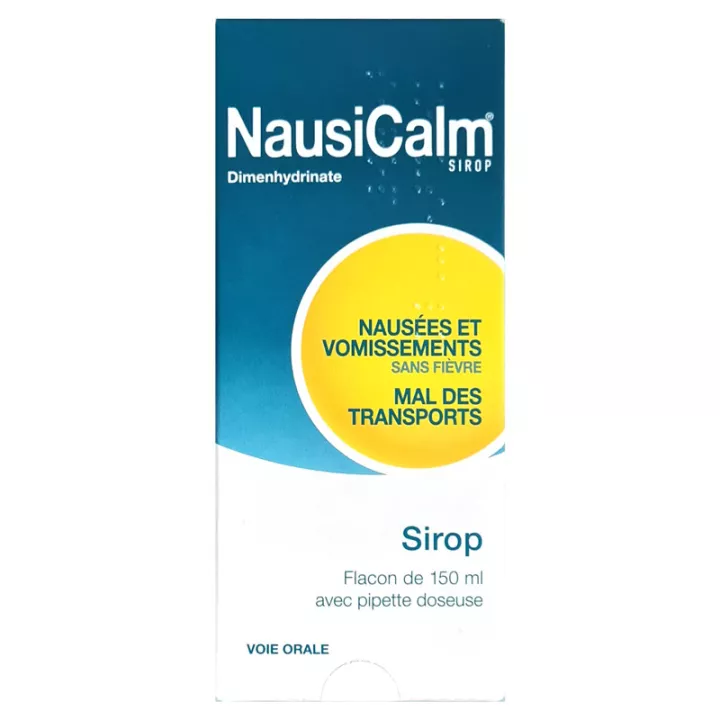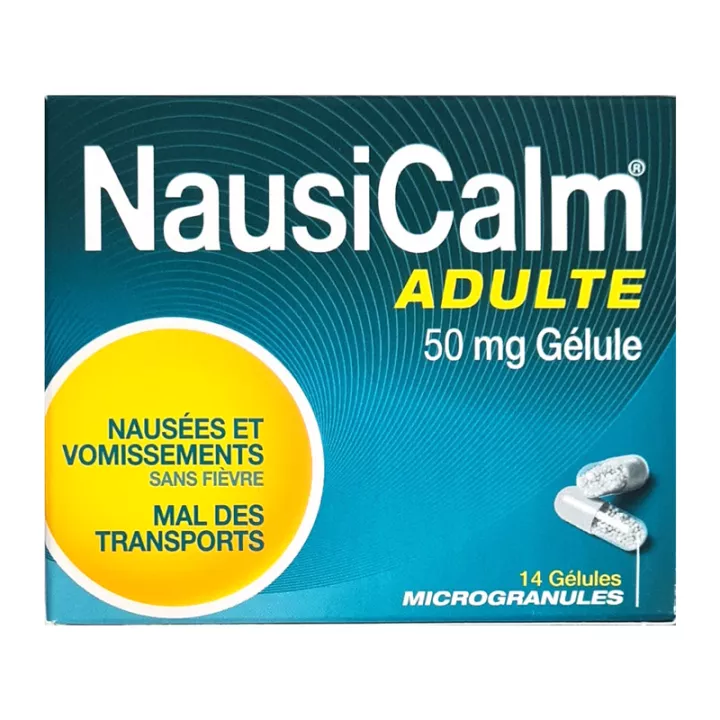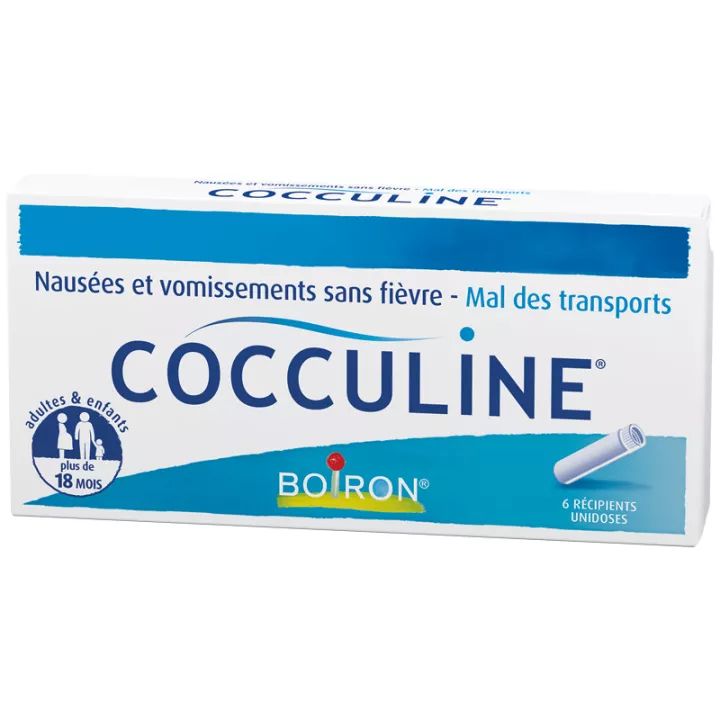NOTICE
ANSM - Last updated: 23/06/2017
Name of the medicinal product
NAUSICALM syrup
dimenhydrinate
framed
Read this leaflet carefully before you start taking this medicine. It contains important information for your treatment.
If you have any further questions, ask your doctor or pharmacist.
· Keep this leaflet, you may need to read it again.
· If you need more information and advice, ask your pharmacist.
· If symptoms worsen or persist, consult your doctor.
· If you notice any side effects not listed in this leaflet, or if you experience any of the effects listed as serious, please tell your doctor or pharmacist. See section 4.
Review summary
In this notice :
1. WHAT IS NAUSICALM, syrup AND IN WHAT CASES IS IT USED?
2. WHAT ARE THE INFORMATION TO BE KNOWN BEFORE TAKING NAUSICALM, syrup?
3. HOW TO TAKE NAUSICALM, syrup?
4. WHAT ARE POSSIBLE SIDE EFFECTS?
5. HOW TO STORE NAUSICALM, syrup?
6. ADDITIONAL INFORMATION
1. WHAT IS NAUSICALM, syrup AND IN WHAT CASES IS IT USED?
Pharmacotherapeutic group
ANTINAUPATHIQUE.
(N: Central nervous system)
Therapeutic indications
This medication is indicated for:
· prevent and treat motion sickness in adults and children as early as 2 years ,
· treat passive nausea and vomiting (no more than 2 days) and not accompanied by fever, in adults and children from 6 years only.
2. WHAT ARE THE INFORMATION TO BE KNOWN BEFORE TAKING NAUSICALM, syrup?
List of information needed before taking the medication
If your doctor has told you about an intolerance to some sugars, contact your doctor before taking this medicine.
Cons-indications
This medicinal product should NOT be used in the following cases:
· certain forms of glaucoma (increased pressure in the eye),
· difficulty urinating with prostatic or other origin,
· allergy known to antihistamines (products intended to treat certain allergies),
· children under 2 years of age in the prevention and treatment of motion sickness,
· children under 6 years of age in the treatment of transient nausea and vomiting. Nausea and vomiting occurring in children under 6 years of age may have a variety of origins and should therefore lead to medical consultation.
This medication SHOULD NOT BE USED, unless otherwise instructed by your doctor, in case of breast-feeding.
IN CASE OF DOUBT, IT IS ESSENTIAL TO ASK FOR THE OPINION OF YOUR DOCTOR OR YOUR PHARMACIST.
Precautions for use; special warnings
Take special care with NAUSICALM, syrup:
Special warnings
Warning! This medicine contains alcohol: 3.15 g per 150 ml bottle. |
This medicine contains sucrose. Its use is not recommended in patients with intolerance to sucrose (rare hereditary disease).
This medicinal product contains methyl parahydroxybenzoate (E218) and propyl parahydroxybenzoate (E216) and may cause allergic reactions.
IN CASE OF DOUBT, IT IS ESSENTIAL TO ASK FOR THE OPINION OF YOUR DOCTOR OR YOUR PHARMACIST.
Precautions for use
· This medication contains 3.6 g of sucrose per teaspoonful and 10.8 g of sucrose per tablespoon, which should be taken into account in the daily diet in the case of a low-sugar diet or diabetes.
· Due to the presence of alcohol, tell your doctor about liver disease, epilepsy or pregnancy.
· For caution, do not use this medication in patients with bronchial asthma.
· In case of long-term liver or kidney disease , CONSULT YOUR DOCTOR so that he can adapt the dosage.
· Taking this medication requires a MEDICAL ADVICE in the elderly:
o predisposed to constipation, dizziness or drowsiness,
o with prostate disorders.
PREVENT YOUR DOCTOR before taking this antihistamine.
The occurrence of signs or symptoms suggestive of abuse or drug dependence of dimenhydrinate should be carefully monitored.
IN CASE OF DOUBT, DO NOT HESITATE TO ASK FOR THE OPINION OF YOUR DOCTOR OR YOUR PHARMACIST.
Interaction with other medicines
Taking or using other medicines
If you are taking or have recently taken any other medicines, including medicines obtained without a prescription, talk to your doctor or pharmacist.
This medicine contains an antihistamine, dimenhydrinate. Other medicines contain it. Do not combine them to avoid the maximum recommended dose ( see Dosage ). |
Interactions with food and beverages
Food and drinks
This medication may cause drowsiness, increased by alcohol: refrain from alcoholic beverages or medicines containing alcohol during the course of treatment.
Interactions with Herbal Medicines or Alternative Therapies
Not applicable.
Use during pregnancy and lactation
Pregnancy and breast feeding
Do not take this medicine without consulting your doctor or pharmacist. |
Pregnancy
This medication will only be used during pregnancy on the advice of your doctor. If you discover that you are pregnant during treatment, consult your doctor as he alone can judge the need to continue.
In late pregnancy, this medication may cause adverse effects in the newborn. Therefore, always seek the advice of your doctor before using it and in no case exceed the recommended dosage.
Ask your doctor or pharmacist for advice before taking any medicine.
feeding
This medication passes into breast milk and is not recommended for use in breastfeeding.
Ask your doctor or pharmacist for advice before taking any medicine.
Sport
Not applicable.
Effects on ability to drive or use machines
Driving and using machines
The drowsiness and decreased alertness associated with the use of this medication can be significant and make driving hazardous and machine use dangerous .
This phenomenon is accentuated by the use of alcoholic beverages or medicines containing alcohol, which should be avoided .
List of excipients with known effect
List of excipients with known effect: sucrose, methyl parahydroxybenzoate (E218), propyl parahydroxybenzoate (E216).
3. HOW TO TAKE NAUSICALM, syrup?
Instructions for proper use
Not applicable.
Dosage, Mode and / or route (s) of administration, Frequency of administration and Duration of treatment
Dosage
· Travel sickness
o Child 2 to 5 years: 1/2 to 1 teaspoon.
o Maximum dose: 75 mg / 24 h, ie 5 teaspoons per 24 hours.
o Children from 6 to 15 years: 1 to 2 teaspoons.
Maximum dosage: 150 mg / 24 h, ie 10 teaspoons per 24 hours.
o Adult (from 15 years): 1 to 2 tablespoons.
Take or administer this medication half an hour before departure. His catch may be renewed during the trip.
· In the symptomatic treatment of nausea and vomiting not accompanied by fever in adults and children from 6 years
o Children from 6 to 15 years: 1 to 2 teaspoons every 6 to 8 hours.
Maximum dosage: 150 mg / 24 h, ie 10 teaspoons per 24 hours.
o Adult (from 15 years): 1 to 2 tablespoons every 6 to 8 hours.
Maximum dosage: 400 mg / 24 h, ie 8 tablespoons per 24 hours.
Administration mode
Oral use.
Frequency of Administration
If you take or give NAUSICALM syrup to prevent motion sickness, take it or administer it half an hour before departure. During the journey, the catch may be renewed, without exceeding the maximum recommended doses.
Duration of the treatment
If you take or give NAUSICALM syrup to treat nausea and vomiting without fever (ONLY in adults and children from 6 years of age), do not exceed 2 days of treatment. If symptoms persist beyond 2 days, medical advice is required.
Symptoms and Instructions for Overdose
If you have taken more NAUSICALM, syrup than you should:
In case of massive absorption, malaise or disturbed consciousness, STOP TREATMENT AND IMMEDIATELY CONSULT A DOCTOR.
Instructions for omission of one or more doses
Not applicable.
Risk of withdrawal syndrome
Not applicable.
4. WHAT ARE POSSIBLE SIDE EFFECTS?
Description of adverse reactions
Like all medicines, NAUSICALM, syrup is likely to have unwanted effects, although not everyone is subject to it.
· Some side effects require STOPPING IMMEDIATELY TREATMENT AND WARNING A DOCTOR
o Allergic reactions:
§ rash type (erythema, eczema, purpura, urticaria);
§ angioedema (urticaria with sudden swelling of the face and neck, which can cause respiratory discomfort);
§ anaphylactic shock.
o Significant decrease in white blood cells in the blood, which may be manifested by the onset or recurrence of fever with or without signs of infections.
o Abnormal decrease in platelets in the blood that may result in nosebleeds or gums.
· Other side effects may include:
o Drowsiness, decreased vigilance.
o Memory or concentration disorders, dizziness (more common in the elderly), impaired balance.
o Motor incoordination, trembling.
o Confusion, hallucinations.
o Dry mouth , visual disturbances, urine retention, constipation, palpitations, low blood pressure.
· More rarely, signs of excitement (agitation, nervousness, insomnia) may occur.
· Very rare cases of abnormal movements of the head and neck in children.
· Cases of abuse and drug dependence with dimenhydrinate have been reported.
· If you notice any side effects not listed in this leaflet, or if any of the side effects gets serious, contact your doctor or pharmacist.
Declaration of side effects
If you notice any side effects, talk to your doctor or pharmacist. This also applies to any side effects not listed in this leaflet. You can also report adverse reactions directly via the national reporting system: National Agency for the Safety of Medicines and Health Products (Ansm) and network of Regional Centers of Pharmacovigilance - Website: www.ansm.sante.fr .
By reporting adverse reactions, you are helping to provide more information about the safety of the drug.
5. HOW TO STORE NAUSICALM, syrup?
Keep this medicine out of the reach and sight of children.
Expiration date
Do not use NAUSICALM, syrup after the expiry date stated on the vial.
Storage conditions
After first opening the bottle: the syrup is kept for 30 days.
Store in the original package in order to protect from light.
If necessary, warnings against visible signs of deterioration
Medicines should not be disposed of via wastewater or household waste. Ask your pharmacist what to do with unused medications. These measures will help protect the environment.
6. ADDITIONAL INFORMATION
Full list of active substances and excipients
What does NAUSICALM, syrup contain?
The active substance is:
Dimenhydrinate ................................................. .................................................. 0.472 g
For 150 ml.
The other components are:
Sucrose, caramel flavor, methyl parahydroxybenzoate, propyl parahydroxybenzoate, purified water.
Pharmaceutical form and content
What is NAUSICALM, syrup and contents of the outer packaging?
This medication is in the form of a syrup. Bottle of 150 ml.
Name and address of the marketing authorization holder and the holder of the manufacturing authorization responsible for the release of the lots, if different
Holder
NOGUATED LABORATORIES
43, RUE DE NEUILLY
92000 NANTERRE
exploiting
NOGUATED LABORATORIES
43, RUE DE NEUILLY
92000 NANTERRE
Maker
NOGUATED LABORATORIES
43 RUE DE NEUILLY
92000 NANTERRE
Names of the medicinal product in the Member States of the European Economic Area
Not applicable.
Date of approval of the notice
The last date on which this leaflet was approved is {date}.
AMM under exceptional circumstances
Not applicable.
Internet Information
Detailed information on this medicine is available on the ANSM website (France).
Information for health professionals only
Not applicable.
Other
SANITARY EDUCATION COUNCILS
WHAT TO DO IN CASE OF NAUSEES AND VOMITIONS?
Nausea and vomiting are common symptoms. They can occur in response to unpleasant odors, in response to poorly accepted food, or in the context of motion sickness.
In case of vomiting, it is necessary to think of drinking, often, salty or sweetened drinks to compensate for the loss of liquid due to vomiting.
However:
· If other disorders appear (pain and / or fever), or if they recur.
· If vomiting is accompanied by bile or blood.
· If nausea and vomiting persist for more than 2 days despite treatment.
· If nausea and vomiting worsen.
CONSULT YOUR DOCTOR IMMEDIATELY because it can be serious pathologies.











